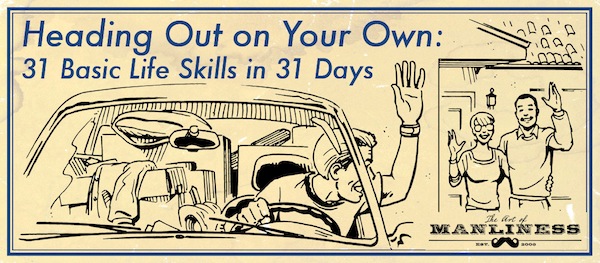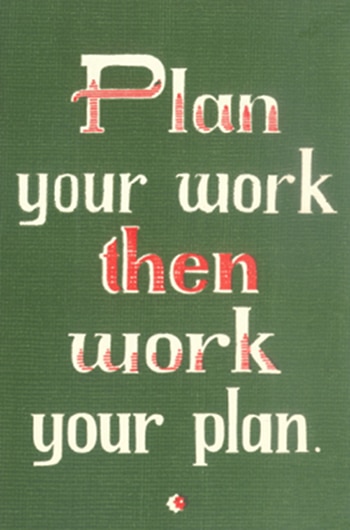
This article series is now available as a professionally formatted, distraction free paperback or ebook to read offline at your leisure.
Growing up, each day is pretty well-scheduled out for you. School from morning til afternoon. After school sports or a job. Homework. Time for bed. Once you leave home for the first time, all that structure is gone; it is up to you to shape each day and get things done. It’s an open plain of freedom, and the way is so broad many young men get completely lost.
It happened to me. One of the things I struggled with the most my first few months away from home was managing my time. I pretty much was flying by the seat of my pants every day. Things in my life started falling between the cracks very quickly, and I soon found myself struggling beneath an overwhelming pile of to-do’s and obligations.
Things turned around for me as soon as I instituted a new habit: weekly planning. Stephen Covey’s (R.I.P.) First Things First was the catalyst for the change. When I got to law school, my weekly planning sessions became even more crucial. The rigors of my legal studies on top of my work on the law review and the Art of Manliness required that I had my days planned to the minute so that I could get everything done.
The power of weekly planning lies in the perspective and control it provides for your life; instead of drifting along, you give yourself a birds-eye view of the maze below, and harness your newfound freedom in order to do, be, and get wherever you want to go. It allows you to manage the day-to-day and often trivial tasks along with your long-term plans and goals. Think of your weekly calendar as an Attack Plan for Life: it’s where you hash out the tactics and logistics to make your long-term vision a reality.
Below I share how I go about my Weekly Attack Plan sessions. It’s sort of a mishmash of time and task management ideas from Stephen Covey and David Allen. I don’t claim that it’s the best way to plan your week, but it’s worked for me. Maybe it will work for you, too, or at least inspire you to come up with you own system.
Watch the Video
Establish Your Attack Plan Day & Set Aside an Hour to Plan
Pick a day that you’ll use to establish your Weekly Attack Plan. The weekend is a good time to do it because it allows you to both review the previous week’s successes and failures and look ahead to the next week. I do mine on Sunday. I know some folks who do theirs on Friday. Pick whichever day works best for you.
Set aside about an hour on your chosen day for planning. The first few times you execute a Weekly Attack Plan session it may take you longer, but that’s okay. After awhile, you’ll establish a rhythm that will allow you to breeze through it in about 45 minutes.
Go somewhere where you can be alone and away from distractions. I like to do my weekly planning sessions on Sunday nights in our home office. When I was in college, I’d go to a quiet corner of the Student Union.
Pick Your Calendaring Tool

Everyone has their own preference for what to use for calendaring. Some people prefer digital calendaring tools like iCalendar, Outlook, or Google Calendar; others prefer using good old-fashioned pencil and paper to plan.
Each format has pros and cons. Digital calendars make planning re-occurring events a breeze. They also can send friendly reminders to you via email or simply as a pop-up on smartphone screens a few minutes before your event. It’s kind of like having a personal assistant. Many digital calendars also allow you to share calendars with others, which can come in handy when trying to sync multiple schedules.
The downside of digital calendars, in my experience, is that they’re kind of a pain when it comes to adding new events, especially on your smartphone’s tiny keypad. You have to type in the event, select the time, and decide if you want a reminder. Granted, once an event is created, moving things around is a snap — just point and click. Voice recognition software like Apple’s Siri is beginning to eliminate this problem, but sometimes Siri goofs up my schedule. Digital calendars also share a downside common to all digital tools: if your device runs out of power, you can’t access your calendar.
With paper and pencil calendars, you don’t have to worry about running out of power. When you want to add a new event, you can scribble it down in seconds. There’s also something about the tactile nature of planning with pencil and paper that really gets your strategic juices going. And because we’re on our phones and computers so much these days, it’s nice to give your brain a break with something different. But there are a few downsides to paper and pencil calendars. If you lose your calendar, you’re sunk. Unlike digital calendars that exist eternally in the “Cloud,” when you lose a pencil and paper calendar, you’ll have to recreate it from memory. You don’t get any email reminders about upcoming events with an analog calendar. And if you have re-occurring events, you’ll have to write them out every. single. week. on a new weekly calendar.
I used to be a pencil and paper planner guy, but switched to digital calendaring tools this year. I like having everything synced up across all my devices. Experiment with the different calendaring tools out there and pick the one that’s comfortable for you. If you’re looking for a good pencil and paper weekly calendar, you can download the one I created for myself when I was in law school.
Perform a Mind Dump to Free-up Mental RAM
During the week, our minds build up a giant list of stuff that needs to be done: call mom back, do the laundry, respond to your backlog of emails, study, etc. The problem with these loose ends camping on our craniums is that they’re subtly eating up our willpower, causing us to feel stressed out and mentally fatigued.
These unfinished mental tasks are like programs you have running on your computer, but aren’t actually using. We’ve all had those moments working on our computer when its fan is running full blast, and everything seems to be taking an eternity to load. You check the Activity Monitor only to see that a bunch of unused apps are hogging a crapload of memory, causing your World of Warcraft raid to screech to a halt. Just as unused computer programs use up precious RAM and slow down your computer, so too do unfinished tasks use up willpower and slow down your brain.
Free-up some mental RAM and get your brain running on all six cylinders again by performing a mind dump. A mind dump is exactly what it sounds like: you get everything out of your head and onto paper (or computer screen). You can actually feel your brain let out a sigh of relief as you write down the stuff it’s been spending precious willpower trying to remember.
Use whatever tool you’re comfortable with for a mind dump. It doesn’t matter. I know several people who use a notebook and pen and others that use digital tools like OmniFocus, Things, Nozbe, or Evernote to capture their mind dump (I use Things). The important thing is simply that you have someplace to store your mind dump.
Once you settle on a capture tool, simply start writing or typing all the tasks, ideas, and commitments that have been weighing you down during the previous week. If you need some nudging on the types of open loops you might having running in your mental background, check out this “trigger” list from David Allen’s Getting Things Done. It’s like a laxative for your brain. Just go down the list and capture any unfinished tasks that come to you as you read through it.
We’ll schedule items from our mind dump later.
Review Your Life Plan & Goals
Now that we’ve detoxed our brains and freed up some mental RAM, it’s time to review our life plan and long-term goals. This step will help you keep “first things first” in mind as you plan your week out and ensure you’re staying on track with your long-term goals. Sure, you may have been successful in completing your short-term goals, but if those short-term goals get you off track with your future aims, what good are they? If needed, reevaluate your short-term to-do list in light of your long-term goals. You might need to amend your life plan and goals as well, as new experiences and insights change your vision of where you want to be down the road.
Don’t have a life plan or goals? Well, now’s the time to create them. To learn how, check out our comprehensive guide on creating a life plan.
Review the Previous Week
Reflect on your previous week and how you performed in your various roles as a man. How did it go? Did you achieve the goals you set for yourself? What were your successes and failures? How could have you done things differently? Any tasks or items you need to follow-up on? I recommend writing down any thoughts that come to you during your reflection on the previous week in a journal. First, the act of writing helps make your thoughts more concrete and well thought-out. Second, by writing down your observations about the previous week, you create a record that you can look back on to see if you’re improving.
Set Weekly Goals

After I’ve reviewed my previous week, I start setting goals for the coming one. I use Stephen Covey’s role-based goal-setting method, but if you have a method that works better for you, use it.
Here’s how the role-based goal-setting method works. When I created my life plan, I defined and prioritized the different roles I fill as a man: husband, father, brother/son, friend, writer, and business owner. Your roles might be student, friend, roommate, boyfriend, etc. Every week I create a goal that I want to accomplish within each role. So for example, a goal for my role as a husband could be to write Kate a love note or take her on a date; a goal for my role as a writer could be to check out and read a book about improving my writing.
I also follow Covey’s advice on creating weekly “Sharpening the Saw” goals. As you saw away at your goals, the blade is going to become dull — you have to take the time to sharpen it up. Thus Sharpening the Saw goals are all about keeping yourself sharp in all aspects of your life: physically, mentally, socially/emotionally, and spiritually. I try to create a weekly goal for improvement in all of those four areas. A weekly physical goal could be to bench press x-amount of weight; a mental goal could be to read a book or listen to a lecture on your commute to work; a social goal could be to write your college bud a letter; and a spiritual goal could be to meditate every day for 15 minutes.
Lay a Foundation for Success With Re-occurring Time Blocks
After I’ve set my goals for the coming week, I move on to putting them in my calendar. I first block out time on my weekly schedule for my Sharpening the Saw goals. These are small and simple things that keep me feeling sharp no matter what sort of chaos happens during the week. So I have time blocked off for exercising, reading, and prayer and meditation. An important part of keeping your saw sharp is weekly and daily planning, so I block time off for it, too. I treat these events like a doctor’s appointment — I don’t schedule anything else during these times and don’t deviate from them unless it’s an emergency. I’ve blocked times off every day in the week for these activities and have my iCal programmed so that they repeat every week.
Block Out Time for Your “Big Rocks”
I attended a seminar once where the instructor was lecturing on time. At one point, he said, “Okay, it’s time for a quiz.” He reached under the table and pulled out a wide-mouth gallon jar. He set it on the table next to a platter with some fist-sized rocks on it. “How many of these rocks do you think we can get in the jar?” he asked.
After we made our guess, he said, “Okay. Let’s find out.” He set one rock in the jar…then another…then another. I don’t remember how many he got in, but he got the jar full. Then he asked, “Is the jar full?”
Everybody looked at the rocks and said, “Yes.”
Then he said, “Ahhh.” He reached under the table and pulled out a bucket of gravel. Then he dumped some gravel in and shook the jar and the gravel went in all the little spaces left by the big rocks. Then he grinned and said once more, “Is the jar full?”
By this time we were on to him. “Probably not,” we said.
“Good!” he replied. And he reached under the table and brought out a bucket of sand. He started dumping the sand in and it went in all the little spaces left by the rocks and the gravel. Once more he looked at us and said, “Is the jar full?”
“No!” we all roared.
He said, “Good!” and he grabbed a pitcher of water and began to pour it in. He got something like a quart of water in that jar. Then he said, “Well, what’s the point?”
Somebody said, “Well, there are gaps and if you really work at it, you can always fit more into your life.”
“No,” he said, “that’s not the point. The point is this: if you hadn’t put these big rocks in first, would you ever have gotten any of them in?“
Most young men fill their schedules with the gravel, sand, and water of life first. Sure, they look and feel busy, but all they ever work on are the small tasks that are likely inconsequential in the long run. You’ll find these sorts of gents wistfully lamenting that they never have time for the things that are truly important in life: the Big Rocks.
What the object lesson above teaches us is that if we want to accomplish our most important goals and tasks, we need to put them in our schedule first. Those smaller tasks can get done during the gaps between your Big Rocks.
What’s a Big Rock? It’s going to be different for every man. Look at your mind dump list and pick three or four items that you consider to be your MITs: most important tasks.
If you’re a student, one of your MITs is definitely your education. To ensure that you actually make school a priority, block off time during the week for the following activities:
1. Block off your class and lab times. The most important appointments of your week. Schedule everything else around your class times.
2. Block off reading time for each of your classes. If you have a Monday/Wednesday/Friday schedule, you’ll probably want to block off an hour or two on Sunday/Tuesday/Thursday for reading.
3. Block off time for note review/outlining/homework for each class. You’ll want to set aside time so you can synthesize class notes, do some outlining, and complete any homework assignments you might have. I typically blocked off an hour right after each class for this. If a class was lecture heavy, like ancient Greek philosophy, I’d use that hour right after class to review my notes and update my class outline. If the class was heavy on problem sets, like calculus or symbolic logic, I used the hour to do that day’s assignment and any additional practice problems.
The amount of time you need for note review/outlining/homework will vary. I recommend setting aside at least one hour for each hour spent in class. If you need more time, schedule it.
No matter what your personal Big Rocks are, block off a set amount of time on your calendar to work on them and don’t let anything bump them from your schedule. Remember: Big Rocks first!
Block Out Time for Other Tasks

You’ll feel like a boss after you plan your week.
Take a look at your list of items you captured during your Mind Dump and block out time to accomplish those tasks. So if you need to get the oil on your car changed or make a gift for your girlfriend’s birthday, block off a time on your schedule to complete those tasks.
How do you know which tasks on your Mind Dump list to tackle first? You can use a system where your go through and rate them by importance with “A, B, C” or something like that, and then schedule the A’s to be completed first. But I have personally found that what is most important jumps right out at me as I look over the list.
My goal by the end of my planning sessions is to have every one of my waking hours of every day of the week blocked out with something. Don’t get the wrong idea. I’m not constantly doing something every minute of the day — I schedule time for doing absolutely nothing too — but I like to have at least an outline of how I’m going to spend my time during the week. I consider my completely filled-in weekly calendar just a rough draft of my week and expect to edit and adjust during my daily planning sessions. Which leads me to…
Review and Adjust Your Weekly Attack Plan Daily
Even the best laid plans need adjusting. That’s why daily planning is so important. Every evening, I’ll review my calendar and make adjustments as needed. While I try to avoid rescheduling my Sharpen the Saw and Big Rock events, I move around the other tasks I scheduled during my Weekly Attack Plan session with gusto. Do likewise.
Do It Again Next Week (And the Week After That, And the Week After….)
If you want to see success come from your Weekly Attack Plan sessions, you have to do them consistently. I’ll admit that I’ve had my moments where I’ve fallen off the wagon on it. Kate can usually tell when I haven’t been planning my week out, because I get unproductive and grouchy — totally off my game. I just don’t function well without the structure of a weekly plan.
I promise as you consistently plan out your week, you’ll find yourself with more motivation, direction, and peace in your life.


